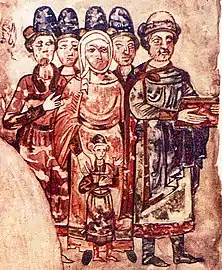Oda of Stade
Oda of Stade (also Oda of Elsdorf) (b.c.1040 – d. 2 July c.1087?) was a German noblewoman, who was the daughter of Ida of Elsdorf. Through marriage to Sviatoslav II of Kiev, she became a Grand Princess consort of Kievan Rus'.[1]
| Oda of Stade | |
|---|---|
 A portrait commissioned in 1073 by Sviatoslav II of Kiev (on right) of Oda of Stade, their young son, Yaroslav, and Sviatoslav’s four sons from a previous marriage | |
| Grand Princess consort of Kievan Rus' | |
| Tenure | 1073–1077 |
| Born | c.1040 |
| Died | c. 2 July 1087? |
| Spouse | Sviatoslav II of Kiev |
| Issue | Yaroslav of Murom Akarina/Aliarina |
| Father | Lippold/Liudolf of Derlingau or Dedi of Saxony |
| Mother | Ida of Elsdorf |
Family
Oda's mother was Ida of Eldsorf (d.1052), daughter of Liudolf, Margrave of Frisia and sister of Matilda of Frisia.[2] Ida was also a niece of Pope Leo IX, a granddaughter of Gisela of Swabia, and thus a niece of Emperor Henry III of Germany.[3] Oda's father was perhaps Ida's first husband, Lippold/Liudolf of Derlingau (d.1038),[4] or he may have been Ida's second husband, Dedi of Saxony (d.1056).[5]
Religious life
According to the thirteenth-century chronicler Albert of Stade, before her marriage, Oda was a nun in the monastery of Rinthelen.[6] The location of this monastery is not known, but is thought to have been Ringelheim.[7] In order to have Oda released from the monastery, her mother Ida granted Villa Stedenthorp near Heßlingen to Rinthelen.[8]
Marriages and children
Around 1065, however, Oda left the monastery and married Sviatoslav II of Kiev, as his second wife.[9] According to the eleventh-century chronicler Lampert of Hersfeld, Oda's brother, Burchard, provost of St Simeon in Trier (d.1086), was sent to Rus’ to arrange the marriage.[10] According to Albert of Stade, this was done at the instigation of Oda's mother Ida.[11] Around 1070 Oda gave birth to Sviatoslav's fifth son, Yaroslav (also known as Constantin), who later became prince of Murom (r.1097-1123, 1127–1129) and Chernigov (r.1123-1127).[12] After Sviatoslav's death (d.1076), Oda returned to the Holy Roman Empire with her son, where she raised him.[13]
Oda is believed to have arranged the marriage of her niece Eupraxia of Kiev to Henry III the Long, Count of Stade.[14]
By her second marriage, to an unknown Saxon nobleman, Oda had a daughter: Akarina of Elsdorf (1079-1130) (whom Albert of Stade refers to as Aliarina), who was the mother of Burchard of Loccum.[15]
References
- Bautier, ‘Anne de Kiev,’ p. 545.
- Zajac, 'Marriages,' p. 721
- Annales Stadenses, a.1112, p. 319; Bautier, ‘Anne de Kiev,’ p. 544; Raffensperger, Reimagining Europe, p. 80; Bloch, ‘Verwandschaft,’ p. 188.
- Annales Stadenses, a.1112, p. 319; Hlawitschka, Untersuchungen, pp. 128-32.
- Jackman, Canes palatini, esp. pp. 6-7.
- Annales Stadenses, a.1112, p. 319.
- Hucke, Grafen von Stade, p. 68.
- Annales Stadenses, a.1112, p. 319.
- Bloch, ‘Verwandschaft,’ p. 190; Dimnik, Dynasty, p. 38; Jackman, Canes palatini, p. 16.
- Lampert of Hersfeld, Annales, a.1075, p. 202; Hucke, Grafen von Stade, p. 68.
- Annales Stadenses, a.1112, p. 319.
- Dimnik, Dynasty, p. 40.
- Raffensperger, Reimagining Europe, p. 80; Bloch, ‘Verwandschaft,’ pp. 189-90.
- Hucke, Grafen von Stade, p. 69; Zajac, 'Marriage,' p. 722.
- Annales Stadenses, a.1112, p. 319; Hucke, Grafen von Stade, p. 69.
Primary sources
Secondary sources
- R-H. Bautier, ‘Anne de Kiev, reine de France, et la politique royale au XIe siècle: étude critique de la documentation,’ Revue des Études Slaves 57:4 (1985), 539–564.
- R. Bloch, ‘Verwandtschaftliche Beziehungen des sächsischen Adels zum russischen Fürstenhause im XI. Jahrhundert,’ in L. Santifaller, ed., Festschrift Albert Brackmann (Weimar, 1931), pp. 185–206.
- M. Dimnik, The Dynasty of Chernigov, 1054–1146 (Pontifical Institute of Mediaeval Studies, 1994).
- E. Hlawitschka, Untersuchungen zu den Thronwechseln der ersten Hälfte des 11. Jahrhunderts und zur Adelsgeschichte Süddeutschlands. Zugleich klärende Forschungen um "Kuno von Öhningen" (Sigmaringen, 1987).
- R. Hucke, Die Grafen von Stade 990-1144 (Stade, 1956).
- D.C. Jackman, Canes palatini: Dynastic Transplantation and the Cult of St. Simeon (Editions Enlaplage, 2010).
- C. Raffensperger, Reimagining Europe: Kievan Rus' in the Medieval World (Harvard University Press, 2012).
- T. Zajac, 'Marriage Impediments in Canon Law and Practice: Consanguinity Regulations and the Case of Orthodox-Catholic Intermarriage in Kyivan Rus, ca. 1000 – 1250,' in Proceedings of the Fourteenth International Congress of Medieval Canon Law, Toronto, 5–11 August 2012, ed. Joseph Goering, Stephan Dusil, and Andreas Thier (Vatican City, 2016), pp. 711–29.